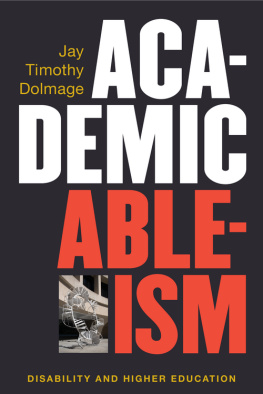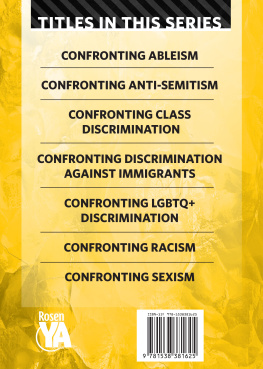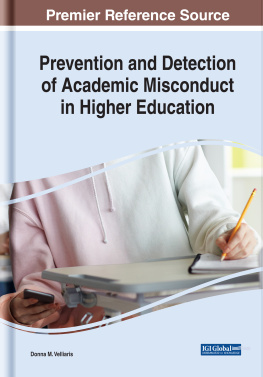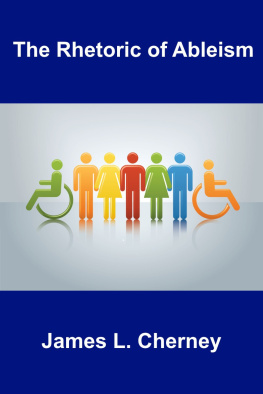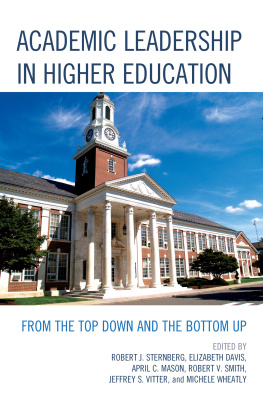Jay Timothy Dolmage - Academic Ableism: Disability and Higher Education
Here you can read online Jay Timothy Dolmage - Academic Ableism: Disability and Higher Education full text of the book (entire story) in english for free. Download pdf and epub, get meaning, cover and reviews about this ebook. year: 2018, publisher: University of Michigan Press, genre: Politics. Description of the work, (preface) as well as reviews are available. Best literature library LitArk.com created for fans of good reading and offers a wide selection of genres:
Romance novel
Science fiction
Adventure
Detective
Science
History
Home and family
Prose
Art
Politics
Computer
Non-fiction
Religion
Business
Children
Humor
Choose a favorite category and find really read worthwhile books. Enjoy immersion in the world of imagination, feel the emotions of the characters or learn something new for yourself, make an fascinating discovery.
- Book:Academic Ableism: Disability and Higher Education
- Author:
- Publisher:University of Michigan Press
- Genre:
- Year:2018
- Rating:4 / 5
- Favourites:Add to favourites
- Your mark:
- 80
- 1
- 2
- 3
- 4
- 5
Academic Ableism: Disability and Higher Education: summary, description and annotation
We offer to read an annotation, description, summary or preface (depends on what the author of the book "Academic Ableism: Disability and Higher Education" wrote himself). If you haven't found the necessary information about the book — write in the comments, we will try to find it.
Academic Ableism: Disability and Higher Education — read online for free the complete book (whole text) full work
Below is the text of the book, divided by pages. System saving the place of the last page read, allows you to conveniently read the book "Academic Ableism: Disability and Higher Education" online for free, without having to search again every time where you left off. Put a bookmark, and you can go to the page where you finished reading at any time.
Font size:
Interval:
Bookmark:

The cover features bold colors and bold, oversize typography. Against a black background the word ACADEMIC is written in white and the word ABLEISM in red. The cover is not wide enough to accommodate the size of these words, so the words are intentionally broken: ACA-, then below this DEMIC, then below this ABLE- and then ISM (suggesting among other things that something in academia is broken). To the left is a small photograph of the sculpture Untitled (Spiral Staircase) by Peter Coffin. The sculpture consists of metal stairs that go nowhere, but instead curve back into themselves in one continuous tangle. The authors name, Jay Timothy Dolmage, appears in the top left corner; at the bottom of the page is the subtitle of the book, DISABILITY AND HIGHER EDUCATION.
Page i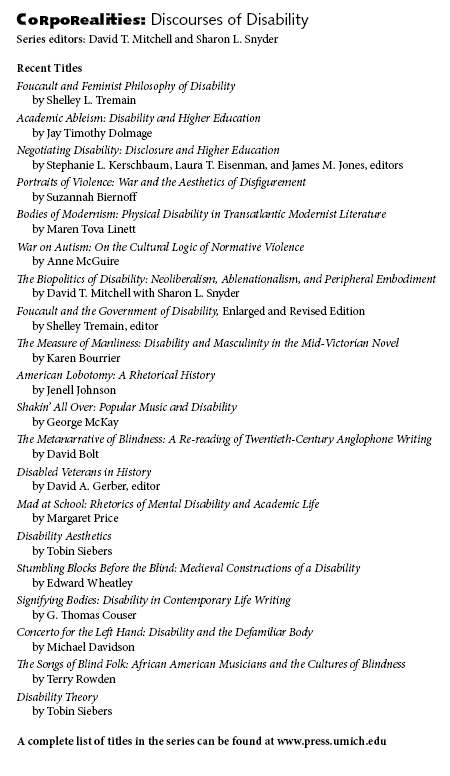 Page iii
Page iii Jay Timothy Dolmage
University of Michigan Press
Ann Arbor
Copyright 2017 by Jay Timothy Dolmage
Some rights reserved
This work is licensed under the Creative Commons Attribution-Noncommercial-No Derivative Works 3.0 United States License. To view a copy of this license, visit http://creativecommons.org/licenses/by-nc-nd/3.0/ or send a letter to Creative Commons, 171 Second Street, Suite 300, San Francisco, California, 94105, USA.
Published in the United States of America by the
University of Michigan Press
Manufactured in the United States of America
A CIP catalog record for this book is available from the British Library.
Library of Congress Cataloging-in-Publication data has been applied for.
ISBN 9780-472073719 (hardcover : alk. paper)
ISBN 9780-472053711 (paper : alk. paper)
ISBN 9780-472123414 (e-book)
http://dx.doi.org/10.3998/mpub.9708722
Cover description for accessibility: The cover features bold colors and bold, oversize typography. Against a black background the word ACADEMIC is written in white and the word ABLEISM in red. The cover is not wide enough to accommodate the size of these words, so the words are intentionally broken: ACA-, then below this DEMIC, then below this ABLE- and then ISM (suggesting among other things that something in academia is broken). To the left is a small photograph of the sculpture Untitled (Spiral Staircase) by Peter Coffin. The sculpture consists of metal stairs that go nowhere, but instead curve back into themselves in one continuous tangle. The authors name, Jay Timothy Dolmage, appears in the top left corner; at the bottom of the page is the subtitle of the book, DISABILITY AND HIGHER EDUCATION.
Page vFor Marilyn Dolmage, still building inclusive schools
Page vi Page viiThanks to all of the folks who have shared their energy and dedication through the Committee on Disability Issues in College Composition over the years, from my mentor Cindy Lewiecki-Wilson to my first, finest, and continued coconspirators Stephanie Kerschbaum, Margaret Price, and Amy Vidali, through to all of those who will continue this work into the future.
Thanks to Brenda Brueggeman for tremendous, honest feedback. Thanks to the University of Michigan Press, the Editorial Board, and LeAnn Fields, for supporting not just the book but also its accessible delivery.
This book is intended to be useful to others, to make space for future advocacy and thinking, and to be built on, critiqued, and exceeded. Like most academic work, nothing here is truly mine, nothing truly new or original. This book is the product of learning with and from others. If I could, Id list hundreds of coauthors, with my name last.
Page x Page 1John Dewey, the famous philosopher of education, in 1895:
It is advisable that the teacher should understand, and even be able to criticize, the general principles upon which the whole educational system is formed and administered. (199)
As Ellen Cushman began writing about the Rhetorician as Agent of Social Change, in her influential article about breaking down the barriers between universities and the communities around them, she first described the steep steps of the Approach, a set of stairs, long in disrepair, between the city of Troy, New York, and Rensselaer Polytechnic Institute. The Approach, for her, symbolized that which prohibit(s) scholars from Approaching people outside the University (374). Every day, she writes, we reproduce this distance so long as a select few gain entrance to universities, so long as we differentiate between experts and novices, and so long as we value certain types of knowledge we can capitalize on through specialization (374). Here is a postcard picture of how the steps used to look (see page 2).
The steps are made of a light gray stone. They are about 20 meters wide on their bottom flight, which is at the forefront of the photo, so that we look up from the very bottom. The steps narrow further up, at the point where two large cylindrical marble columns stand. The steps continue Page 2 to climb up to an imposing set of gates. Behind these gates there are green trees and foliage and, we assume, the university. Five people stand up near the very top of the steps and they look very small, giving perspective on just how steep and massive the approach is.
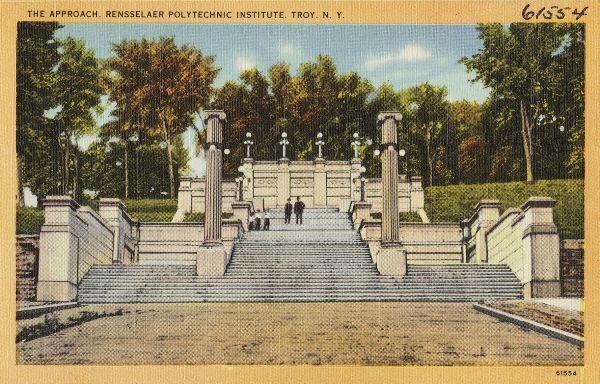 Fig. 1. Postcard: Approach to Rensselaer. Rensselaer Polytechnic Institute Library Archives, 1910.
Fig. 1. Postcard: Approach to Rensselaer. Rensselaer Polytechnic Institute Library Archives, 1910.This postcard image depicts a set of more than 80 steep stone stairs at the public entrance to Rensselaer Polytechnic Institute in Troy, New York.
The very fact that these steps are featured in a postcard reveals the ways that such structures are the stylistic and aesthetic center of many campuses. If we were to object that such steps make the university inaccessible, many universities would make the argument that steep steps are stylistically desirable, that they fit with the template, the architectural fingerprint of the school: all the buildings are the same color, with the same size Ionic columns, maybe even the same number of stairs leading up to buildings. These counterarguments show the ways that in the construction and maintenance of the steep steps there is also a latent argument about aesthetics or appearances, one that trips over to the classroom, into ideology and into pedagogy, where teachers are also sometimes concerned about pattern, clarity, proprietyand these things are believed to be beautiful (access Hunter). Today, the steps in this postcard are in ruins, but the ideology of the steep steps persists, at Rensselaer and elsewhere. Even as universities have become more accepting of diversity, academics tend to stay inside, as Ellen Cushman suggests. And the steps arent the only way in which the university is inaccessible, even Page 3 if they might be the most physically arresting and apparent. As a select few stay in, disability is kept out, often quite literally. If it isnt the steep steps of this approach, it might be the ornate gates you encounter in the approach to Ivy League schools like Harvard and Princetongates that are reproduced in a movie like Monsters University as emblematic of college architecture and its ideology (more on this later).
Font size:
Interval:
Bookmark:
Similar books «Academic Ableism: Disability and Higher Education»
Look at similar books to Academic Ableism: Disability and Higher Education. We have selected literature similar in name and meaning in the hope of providing readers with more options to find new, interesting, not yet read works.
Discussion, reviews of the book Academic Ableism: Disability and Higher Education and just readers' own opinions. Leave your comments, write what you think about the work, its meaning or the main characters. Specify what exactly you liked and what you didn't like, and why you think so.

